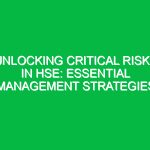Introduction
In the realm of Health, Safety, and Environment (HSE), understanding the concept of risk assessment is paramount. The risk assessment definition can be framed as a systematic process of identifying, evaluating, and prioritizing risks associated with potential hazards in the workplace or environment. This definition is not merely academic; it serves as the foundation for creating safer workplaces and mitigating adverse impacts on health and the environment. By delving into this subject, we can uncover essential insights that highlight the significance of risk assessment in HSE practices.
Risk assessment is more than a regulatory requirement; it is a tool that empowers organizations to safeguard their employees, property, and the environment. By systematically analyzing risks, companies can make informed decisions that protect their workforce and minimize environmental damage. This article will explore the nuances of the risk assessment definition in HSE, its components, methodologies, and real-world applications, while also considering the regulatory landscape that governs these practices.
Understanding Risk Assessment in HSE
To fully appreciate the risk assessment definition in HSE, we must dissect its core components. Risk assessment involves several key steps that can be summarized as follows:
- Hazard Identification: This is the first and foremost step where potential hazards are identified. Hazards can be physical, chemical, biological, ergonomic, or psychosocial in nature.
- Risk Analysis: Once hazards are identified, the next step is to analyze the risks associated with them. This involves evaluating the likelihood of occurrence and the potential severity of harm.
- Risk Evaluation: After analyzing the risks, the next step is to determine whether the risks are acceptable or require control measures. This evaluation helps prioritize which risks need immediate attention.
- Control Measures: Finally, appropriate control measures are developed and implemented to mitigate the identified risks. These may include engineering controls, administrative procedures, or personal protective equipment (PPE).
Each of these steps is crucial in establishing a comprehensive understanding of risk within the HSE context.
The Importance of Risk Assessment in HSE
The importance of risk assessment in HSE cannot be overstated. It plays a critical role in promoting workplace safety and environmental sustainability. Here are some essential insights into its significance:
1. Protecting Employees
A robust risk assessment process helps identify potential hazards that employees may face in their work environment. For instance, in a manufacturing setting, a thorough risk assessment can reveal machinery that poses a risk of injury. By implementing control measures, such as safety guards or training programs, organizations can significantly reduce the likelihood of accidents and injuries.
2. Regulatory Compliance
Most countries have established regulations that mandate organizations to conduct risk assessments. For example, the Occupational Safety and Health Administration (OSHA) in the United States requires employers to assess workplace hazards. Failure to comply can result in penalties, legal liabilities, and reputational damage. Conducting proper risk assessments not only ensures compliance but also fosters a culture of safety within the organization.
3. Financial Benefits
Investing in risk assessment can lead to long-term financial savings. By identifying and mitigating risks early, organizations can avoid costly accidents, litigation, and insurance claims. A case in point is a construction company that implemented a thorough risk assessment program. By addressing potential hazards proactively, the company saw a significant reduction in workplace injuries, ultimately leading to lower insurance premiums and enhanced profitability.
4. Enhancing Reputation
Organizations that prioritize health and safety through effective risk assessment build a positive reputation among employees, clients, and stakeholders. A strong safety record can enhance a company’s brand image and may even provide a competitive advantage in the marketplace.
Best Practices in Risk Assessment
Implementing effective risk assessment practices is crucial for organizations aiming to enhance their HSE standards. Here are some best practices to consider:
1. Involve Employees
Engaging employees in the risk assessment process fosters a culture of safety. Employees are often the best source of information regarding potential hazards as they work directly with tools and equipment. Their insights can lead to more accurate hazard identification and effective solutions.
2. Regular Reviews
Risk assessments should not be a one-time activity. Regular reviews and updates are essential, particularly when there are changes in the workplace, such as new equipment, processes, or personnel. This ensures that the risk assessment remains relevant and effective.
3. Documentation
Maintaining detailed records of risk assessments, findings, and control measures is vital. Documentation serves as a reference point for future assessments and demonstrates compliance with regulatory requirements.
4. Training and Awareness
Providing training on risk assessment procedures and hazard awareness is essential. Employees should be educated on the importance of risk assessment and how they can contribute to maintaining a safe work environment. This not only empowers them but also reinforces the organization’s commitment to safety.
Real-Life Applications of Risk Assessment
To truly grasp the significance of risk assessment in HSE, let’s explore some real-life applications.
Case Study: Oil and Gas Industry
In the oil and gas industry, the stakes are incredibly high due to the potential for catastrophic incidents. Companies like BP employ rigorous risk assessment methodologies to evaluate the potential risks associated with exploration and production activities. Following the Deepwater Horizon incident in 2010, the industry faced intense scrutiny regarding risk assessment practices. As a response, many companies revamped their risk assessment protocols, incorporating advanced technologies and predictive analytics to identify and mitigate risks more effectively.
Case Study: Construction Sector
In the construction sector, risk assessments are conducted before the commencement of any project. A notable example is the use of Building Information Modeling (BIM) technology. Companies like Turner Construction implement BIM to visualize potential hazards in a project’s design phase. By identifying risks early, they can implement preventive measures, such as redesigning certain elements to enhance safety.
Regulations and Standards Governing Risk Assessment
Understanding the regulatory framework surrounding risk assessment is crucial for compliance and effective implementation. Various regulations and standards govern risk assessment practices in different regions.
1. OSHA Regulations
In the United States, OSHA regulations mandate employers to conduct risk assessments to ensure workplace safety. OSHA’s General Duty Clause requires employers to provide a workplace free from recognized hazards. Compliance with these regulations is not only a legal obligation but also a moral duty to protect employees.
2. ISO 45001
ISO 45001 is an international standard that provides a framework for occupational health and safety management systems. It emphasizes the importance of risk assessment in identifying and managing workplace hazards. Organizations seeking ISO certification must demonstrate robust risk assessment practices.
3. EU Regulations
In the European Union, several directives, such as the Framework Directive on Safety and Health at Work, require employers to assess risks and implement preventive measures. These regulations are designed to protect workers and promote a culture of safety across member states.
Conclusion
In conclusion, the risk assessment definition in the context of HSE is a vital process that encompasses identifying, analyzing, and mitigating risks associated with workplace hazards. It plays a crucial role in protecting employees, ensuring regulatory compliance, and enhancing organizational reputation. By adopting best practices in risk assessment, organizations can not only safeguard their workforce but also promote environmental sustainability.
As we move forward in an increasingly complex world, the need for effective risk assessment becomes even more pronounced. Organizations must prioritize this critical process to foster a culture of safety and well-being. Whether in high-risk industries like oil and gas or more conventional sectors like construction, the principles of risk assessment can unlock significant benefits.
By engaging employees, regularly reviewing assessments, maintaining thorough documentation, and providing adequate training, organizations can enhance their HSE practices. Ultimately, risk assessment is not just a regulatory checkmark; it is a commitment to creating a safer, healthier, and more sustainable future for all.


